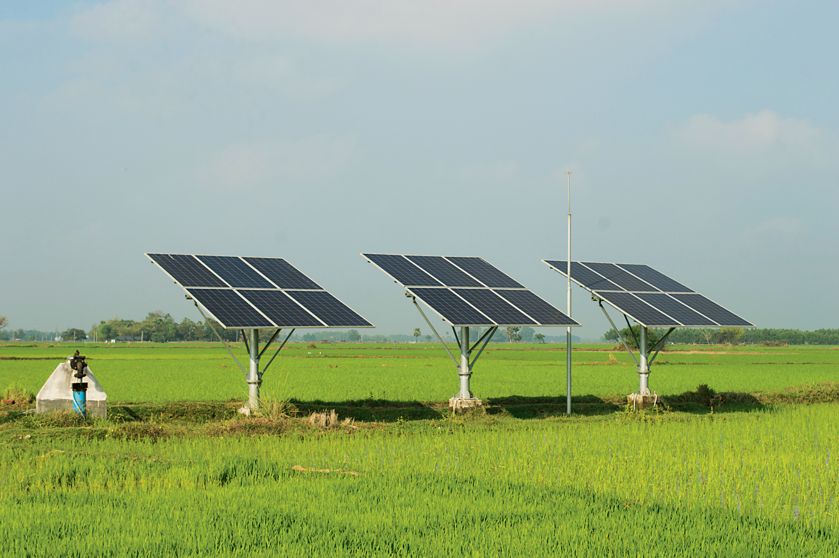
IN line with the UN's Sustainable Development Goals, India's power generation mix is rapidly shifting towards a more significant share of renewable energy. ISTOCK
VP Sethi and SS Gosal
IN line with the UN’s Sustainable Development Goals, India’s power generation mix is rapidly shifting towards a more significant share of renewable energy. Today, India is the world’s third largest producer of renewable energy, with 40 per cent of its installed electricity capacity coming from non-fossil fuel sources. Sunlight, wind, water and biomass are common sources of renewable energy.
Solar energy is an important source that can be converted into heat, mechanical energy and electricity. Its main applications are photovoltaic-driven pumps for irrigation, drying of fruits/spices, ice-making and cold storage (through absorption or heat-driven refrigeration). Micro hydro energy (MHE) can be converted into mechanical energy and electricity. MHE can be directly used in mills and electrical motors. Biomass energy can be converted into heat, electricity, liquid bio-fuels and biogas. It can be used in dryers (fruits, herbs, spices), combustion motor or electric motor (fuels such as ethanol and biodiesel for transportation), anaerobic digester; biogas for lighting, cooking and heating and industrial biogas for decentralised electricity. Biomass is organic material used to generate electricity, produce heat or biofuels for transportation. Bioenergy is derived from wood, agricultural crops, residues, animal byproducts or agro-industrial byproducts.
Punjab produces about 185 lakh tonnes of paddy straw every year. Nearly half of it is managed in situ (mixing the residue in the soil) and ex situ (used as fuel) and the rest is set ablaze. There is a huge scope for using paddy straw bales in the privately owned biomass plants — consuming about 8.8 lakh tonnes of paddy straw — to increase farmers’ income. More such units can be installed for higher straw consumption. The government needs to fix the cost of bales and lifting charges so that farmers can save money from the whole process. Thermal power plants can also use stubble pellets as 5-10 per cent of their total fuel consumption. Entrepreneurs or progressive farmers, with the support of the government, can install pellet units to earn additional income. Seven industrial units manufacturing paper, cement, sugar and edible oil are using stubble as a fuel with a consumption of 3 lakh tonnes. More such industrial units need to be set up for managing paddy straw. Overall, Punjab needs an infrastructural push to switch to ex situ methods such as more biomass-based power plants, pellet-making industry and bio-CNG plants, along with faster and cheaper transportation to take stubble from the farms and storage godowns for off-season use.
An estimate shows that about 80-90 per cent of the country’s irrigation is through groundwater. The demand is being met through 12 million electricity connections and 9 million diesel pumps sets to extract underground water for irrigational use. The government has set a target of generating 450 gigawatts (GW) of energy through renewable sources by 2030. Solar pumps for irrigation have become a cost-effective source of power at a negligible cost, besides cutting down the diesel cost and curbing pollution. Solar pumps have become a viable option for farmers. An estimate shows that these can save 4 billion litres of diesel annually and 5 per cent of the total greenhouse gas emissions. The installation of ground-based solar energy power plants on uncultivable, under-utilised land can provide a consistent source of income for at least 20-25 years. The generated electricity from these solar agri-feeders can reduce agricultural subsidy and infrastructural costs. The solarisation of agricultural pumps offers an additional advantage to the farmers. Through grid-connected pumps, they can sell surplus power back to the grid, creating a secondary source of income.
Another source of income for farmers is unutilised organic waste. They produce raw material required for bio-fuel production in biomass-based cogeneration plants that utilise sugarcane and its byproducts, surplus rice, maize, damaged foodgrains and non-edible seeds to produce biodiesel and ethanol. The blending of petrol and diesel with bio-fuels can further lower emissions as burning of crop residue gets reduced.
With the advancements in photovoltaic (PV) technology and solar industrialisation, the cost of installing and managing a solar energy setup has decreased tremendously, enabling more PV installations across different applications in the agricultural sector, such as solar water pumping systems, solar-powered water and space heating for livestock and dairy operations, solar-powered crop and grain drying systems, solar-powered greenhouse heating and lighting systems. By employing these systems, farmers can easily save costs incurred on electricity consumption from the mains supply. A solar greenhouse has matching-capacity solar panels to collect energy and batteries to store it. Solar-powered cooling systems use the refrigeration effect for a continuous supply of power from the batteries connected to the solar panels, where the power is supplied directly in the morning and the backup power stored is supplied at night.
With effective implementation, a solar energy setup can be very rewarding. Renewable energy and the agriculture sector can be a winning combination that can solve many problems we face today. It can also be a new channel that can help in improving the quality of the crop yield, cutting overhead costs and improving the efficiency of agricultural processes.
PM-KUSUM scheme for ensuring farmers’ energy & water security
Pradhan Mantri Kisan Urja Suraksha evam Utthaan Mahabhiyan (PM-KUSUM) has three components.
Component A: Installation of aggregated 10,000-MW capacity of small solar power plants, each of capacity up to 2 MW, on barren/fallow/pasture/marshy/cultivable land of farmers
Component B Installation of 20 lakh standalone solar water pumps
Component C Solarisation of 15 lakh existing grid-connected agriculture pumps
Sethi is HoD, Mechanical Engg, and Gosal is VC, PAU, Ludhiana
Send your feedback to [email protected]
Join Whatsapp Channel of The Tribune for latest updates.


























